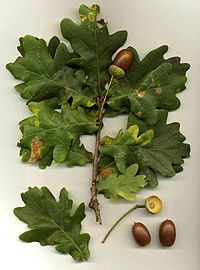
Photo from wikipedia
At present, the distribution area of Fraxinus excelsior L. in the forest ecosystems of the Volga Region is rather low and ranges from 0.01% to 2.5%. In the Middle Volga… Click to show full abstract
At present, the distribution area of Fraxinus excelsior L. in the forest ecosystems of the Volga Region is rather low and ranges from 0.01% to 2.5%. In the Middle Volga Region, using the example of the Penza region, five types of deciduous forests were identified in the composition with Fraxinus excelsior L.: oak forest aegopodium, oak forest nettle, oak forest hazel-linden, oak forest aegopodium-motley grass, oak forest carex-motley grass. In the forest phytocenoses of the Moksha River basin, the quality of Fraxinus excelsior L. is 1.5–1.7. In the forest phytocenoses of the Khoper River basin, the average quality value reaches 2.4–2.8, and in the forest tracts of the Sura river basin it is 2.8–3.2. In the western part of the study area, individuals of age class II–III (21–40, 41–60 years) predominate, in the central part—age class I (1–20 years), in the eastern part—age class V (81–100 years). This circumstance allows us to conclude that its populations in the western regions are represented by stands of different ages; the presence of young stands and middle-aged stands indicates the presence of conditions for reproduction and distribution. At the border of its range, Fraxinus excelsior L. grows in a stable population; in the western part of the Middle Volga Region, the number of species in forest stands with a predominance of Fraxinus excelsior L. is 26–30% higher than this indicator in more eastern regions. In the direction from east to west, the number of species in the composition of forest stands increases (up to 8.4), with a predominance of Fraxinus excelsior L. The number of plant associations increases in the direction from east to west. If in the east of the Penza region Fraxinus excelsior L. occurs in 6–7 plant associations, then in the west of the region—in 18–25 associations. The maximum timber stock for 100 years of Fraxinus excelsior L. stands reaches 380 m3/ha. Such a natural bioresource potential is of importance for the conduct of the national economy. Forest management in phytocenoses with the participation of this tree species is a strategic branch direction. It is expedient to restore populations of Fraxinus excelsior L. everywhere and to cultivate them in the territory of the East European Plain and especially in its south-eastern part. This is fully consistent with the principles of sustainable ecological and economic development against the background of local natural, climatic and geographical conditions. This type is necessary when solving environmental, resource-saving and economic problems in the territory under consideration.
Journal Title: Life
Year Published: 2022
Link to full text (if available)
Share on Social Media: Sign Up to like & get
recommendations!